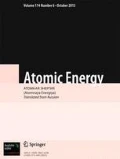The effect of the fume gases, produced when the insulation of chlorine-free cables burns, on the catalytic activity of hydrophobic low-temperature and hydrophilic high-temperature platinum catalysts of hydrogen oxidation, which are to be used in the ventilation-gas detritization system. The temperature regime for the combustion of cables in the presence of an oxygen deficiency is determined and the semiquantitative composition of the products formed is obtained. Upon exposure to the fume gas flow at room temperature the experimental samples of the catalysts were almost completely poisoned. At the initial temperature 473 K of a hydrophilic catalyst thermal activation of the catalyst occurs in the presence of fume gases.
Similar content being viewed by others
References
Sanitary Regulations and Norms SanPiN 2.6.1.2523-0. Radiation Safety Standards NRB-99/2009, Moscow (2009).
R. Wieneke, “Catalytic reaction system for the tritium emission reduction facility,” Fus. Technol., 21, 577–582 (1992).
L. Heung, G. Gibson, and M. Ortman, “Tritium stripping by a catalytic exchange stripper,” ibid., 588–593.
D. Wong, J. Hemmerich, and J. Monahan, “The exhaust detritiation system for the JET active gas handling plant – engineering, construction, installation and first commissioning results,” ibid., 572–576.
L. Heung and M. Rhoden, “Performance of a large-scale glovebox-stripper system,” Fus. Sci. Technol., 41, 583–587 (2002).
A. Perevezentsev and A. Bell, “Development of water detritiation facility for JET,” Fus. Sci. Technol., 53, 816–839 (2008).
A. Perevezentsev, A. Bell, B. Andreev, et al., “Wet scrubber column for air detritiation,” Fus. Sci. Technol., 56, 1455–1461 (2009).
S. Marunich, Yu. Pak, and M. Rozenkevich, “Application of the phase isotopic exchange of water for the purification of air in industrial areas from tritium,” Theor. Found. Chem. Eng., 44, No. 5, 919–923 (2010).
A. N. Perevezentsev, M. B. Pozenkevich, Yu. S. Pak, et al., “Phase isotopic exchange as a method of detritization of gase,” Teor. Osn. Khim. Tekhnol., 47, No. 1, 54–61 (2013).
Yu. A. Sakharovskii, D. M. Nikitin, E. P. Magomedbekov, et al., Patent No. 2307708 RF, “Method of preparing platinum hydrophobic catalyst of isotopic hydrogen exchange with water,” publ. Oct. 10, 2007, Byull. Izobret., Polez. Modeli, No. 28 (2007).
A. N. Bukin, V. I. Petrova, and M. B. Rozenkevich, “Catalyzers of oxidation of trace quantities of hydrogen in nuclear technology,” Abstr. 4th All-Russ. Conf. on Chemical Technology, Moscow (2012), Vol. 3, pp. 532–536.
Author information
Authors and Affiliations
Additional information
Translated from Atomnaya Énergiya, Vol. 120, No. 2, pp. 95–100, February, 2016.
Rights and permissions
About this article
Cite this article
Ivanova, A.S., Bukin, A.N., Marunich, S.A. et al. Catalytic Oxidation of Trace Quantities of Hydrogen in Tritium-Containing Gas Flows in the Event of a Fire at Nuclear Facilities. At Energy 120, 127–133 (2016). https://doi.org/10.1007/s10512-016-0106-y
Received:
Published:
Issue Date:
DOI: https://doi.org/10.1007/s10512-016-0106-y




